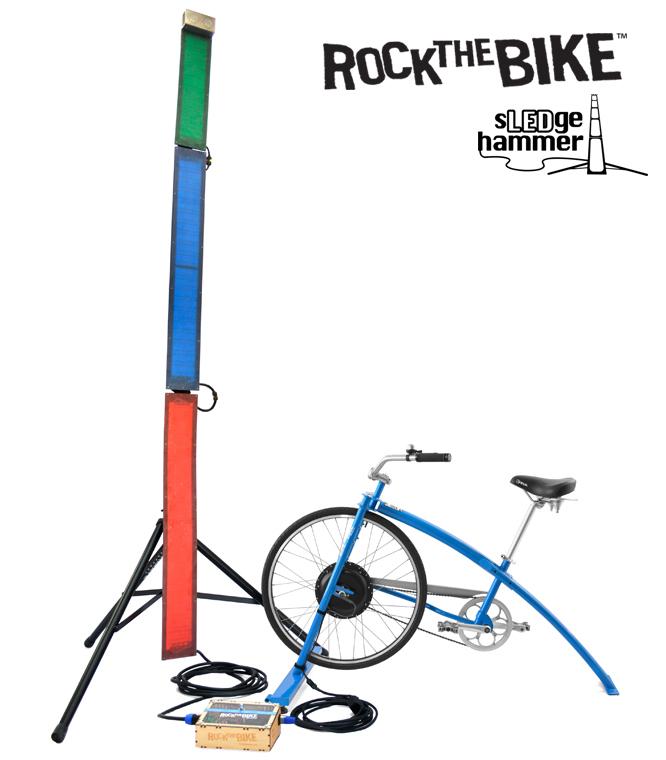Dominique Christina performs “The Praise Poem” at Bicycle Music Festival 2015
It was one of the first spoken word performances at a Bicycle Music Festival and the first we’ve featured in a highlight video. The performance of a poem about being a woman is poignantly set on the Climate Justice! banner, a reminder of how our movements are connected.
If you love the poem as much as we do, check out Dominique Christina’s other videos and web site.
The Pedal Powered Stage was loud and clear that day with 24 Generators in beautiful rainbow formation. The volunteer crew of Bicycle Music Festival transported all the gear you see (with the exception of the elevated stage) by bicycle. The video shows a few short snippets of this huge bicycle roadying effort.
Read MoreWhere can I see a bike blender and taste pedal powered food?!
There are various smoothie shops around the United States that incorporate bike blending and ice cream churning into their business.
Use the interactive map to find your closest location!
Read MoresLEDgehammer

The sLEDgehammer is an interactive light challenge that harkens back to the classic carnival Sledgehammer game. But here, the aim is to convert your peak power output to a beautiful light display. The sLEDgehammer is accurate, motivating, and visible from anywhere in the venue. It’s a fun way to get your event participants thinking, cheering, and breathing.
Customize the color of the Generator Pro Frame.
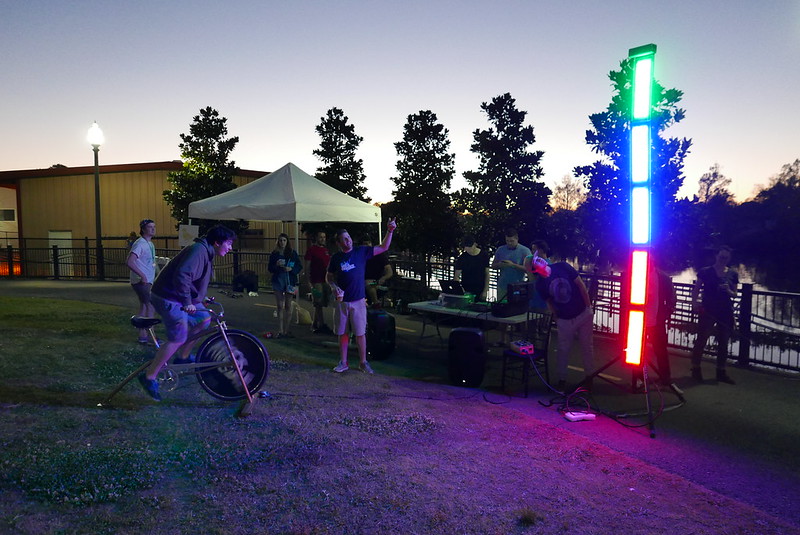
The sLEDgehammer can be purchased as a single-player challenge or a dual:
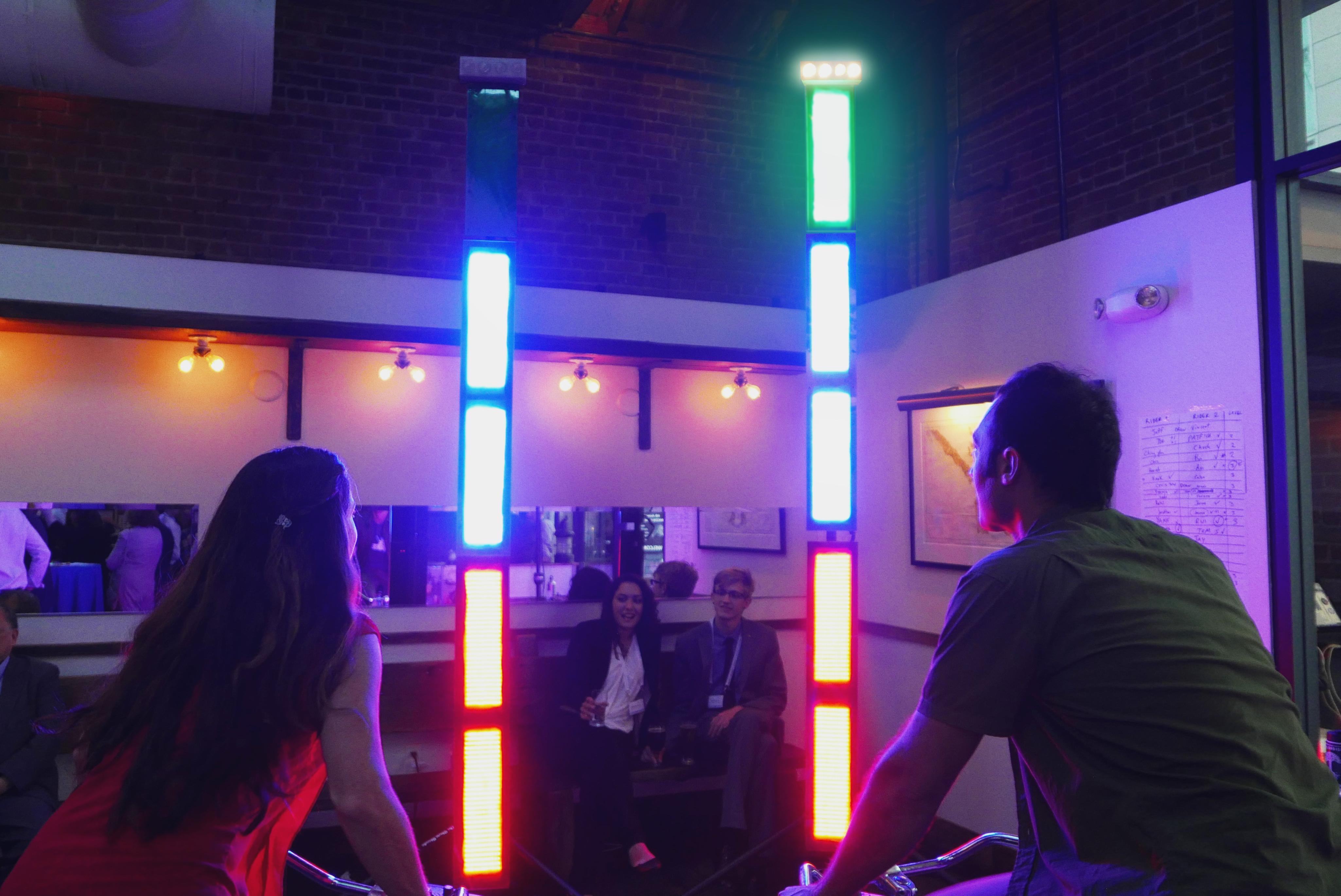
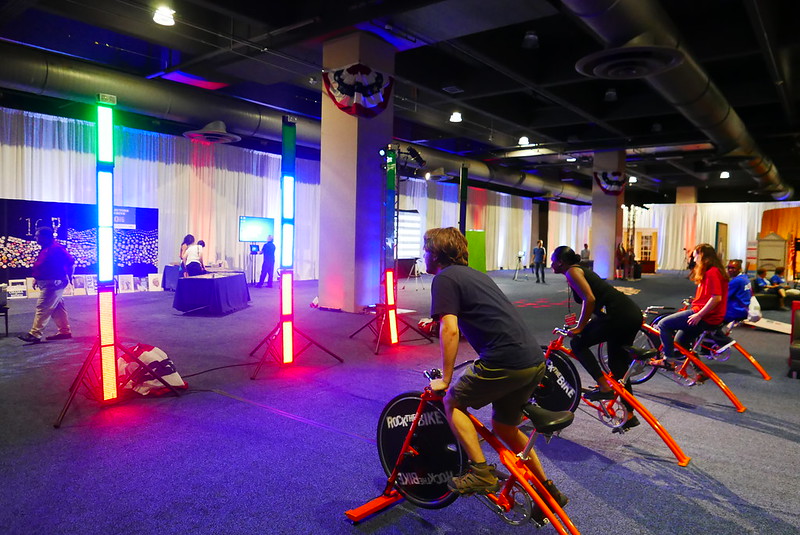
Above: Get multiple sLEDgehammers to add a competitive element and a larger presence at your event.
Rules of the game:
The elements of a sLEDgehammer:
- An efficient bicycle generator, such as the Generator Pro.
- The sLEDgehammer circuit, which comes complete in a strain-reliefed enclosure with an Ultra Capacitor and all power cables.
- 5 colored LED panels standing to a height of 11 feet tall.
- Halogen lights at the top to win the game.
- A wide base untippable tripod stand.
- User manual Here.
The Circuit: The sLEDgehammer circuit is the brains of the operation, calculating watts as you pedal. The sLEDgehammer comes in an enclosed, strain-relieved circuit capable of handling 1500-Watt surges in power. Depending on how many LEDs you connect, you may need all that power handling. People will try to break this machine. The sLEDgehammer circuit runs cool, calm and collected even when your participants pedal their hardest.
The sLEDgehammer runs on an Arduino Pedal Power microcomputer, using the open-source Arduino platform. What this means is that you can optimize or change certain parameters to improve the activity.
***
Custom Installations:

The sLEDgehammer can be installed in several ways. Our favorite method is doing large custom installs like the ones shown on this page. They can either be done for a single event or on a semi-permanent basis. Custom installations use the same components: bike, lights, and circuit; and can be tailored to your event, activity, or facility. We work with you to design and implement the sLEDgehammer. We then provide either full installation and crew at your location or help and guidance for your crew prior to the event.
Recommendations for output devices, i.e. Light:
Please see above about “rules of the game”. There are two lighting segments of a sLEDgehammer — the Challenge Phase and the Reward Sequence. To make the Challenge Phase truly challenging, you need to connect at least 200 Watts of lighting, perhaps as much as 500 for the fittest riders. The most impressive way to achieve this and the best option for a large space is to use LEDs for both the challenge phase and the Reward Sequence. This makes the Challenge Phase visible to much larger groups of people, which increases the crowd interaction. A lower-cost substitution is to use incandescent bulbs for the Challenge Phase, which has the benefit of highlighting the comparative energy efficiency of newer lighting technologies. With incandescents, you can make the Challenge Phase truly challenging. Incandescents will cost less* because you need far fewer of them to achieve the Wattage goals of the Challenge Phase. (* That’s also the reason they are worse for the environment.)
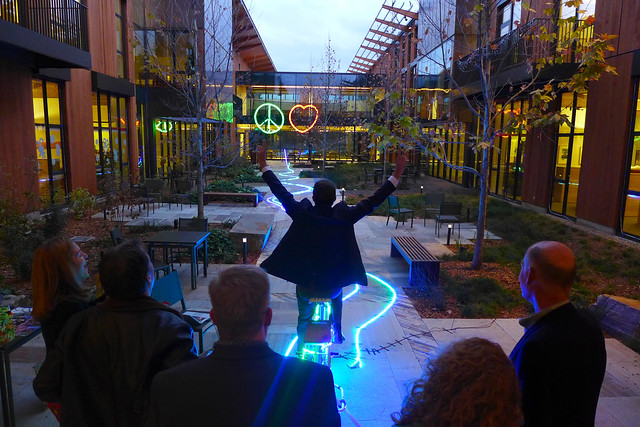
Costs:
11 Foot Tall Tower, Tripod Stand, and Circuit: $3,600.00
Assembled dimensions:
The Generator Pro is 56″ long, 39″ tall, 31″ wide.
Rentable: Yes! Find out more.
Custom Installation: Contact us for options and pricing.
Build Time: Made to order. Please give us 4 weeks to build the sLEDgehammer, 6 weeks for a Dual sLEDgehammer and 2 weeks for the sLEDgehammer circuitry only.
Update from Austin’s first Pedal Powered spin class
Rock The Bike is helping Pure Austin Fitness pedal power their spin class. Pure already owns two of our Fender Blender Pros, and the goal of the current project is to convert these bike blenders to pedal power generators using our latest technology, then use them to pedal power the audio in their spin class. Here are some shots from the work I did in Austin over the past five days.
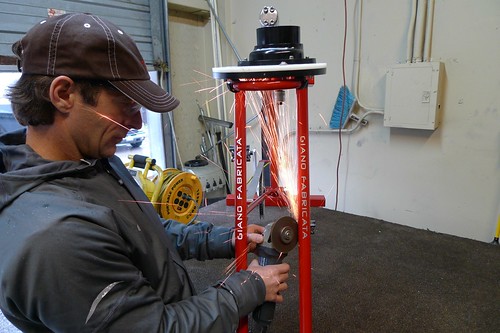
On Friday I met up with Pure Austin’s Beto Boggiano at his workshop. We chopped off the dropouts on the Fender Blender Pro frames, in order to respace them for the new generator hubs.

We used the generator hub itself to position the dropouts at the correct width, rather than, say, measuring the distance with a caliper and then holding the dropouts with a pair of vice grips. The gym mats and wood are to lift the hub and hold it at the correct position for tacking.
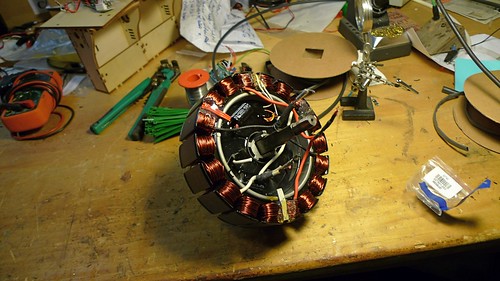
Here’s a shot of the inside of our generator hub. The copper coils move past rare earth magnets that are bonded to the inside of the aluminum hub shell, creating an electric charge that makes current flow through a cross-bridge rectifier. From the Wikipedia page on generators:
A generator forces electric charges to move through an external electrical circuit, but it does not create electricity or charge, which is already present in the wire of its windings. It is somewhat analogous to a water pump, which creates a flow of water but does not create the water inside. The source of mechanical energy may be a reciprocating or turbine steam engine, water falling through a turbine or waterwheel, an internal combustion engine, a wind turbine, a handcrank, compressed air or any other source of mechanical energy.

Above: Beto tacking the dropouts back on in their new position.

After welding the dropouts back to the frame at the correct width, it was time to rebuild wheels around the new hubs. The rim and tire add mass that creates a flywheel, smoothing out the pedal power. Plus, with a tire back on, the tire-rubbing bike blender interface will still completely functional (though optional). Pure Austin will be able to rotate the blender’s roller away from the tire during the spin class (to minimize noise and power loss), and then move it back to crank out smoothies for the cyclists after the class.
Before the trip, Rock The Bike’s engineer Leif had encouraged me to build the wheels ahead of time so that I could devote my time to installing the system once in Austin. Unfortunately I ran out of time preparing for Austin and instead brought rims and spokes with me. I ran into a number of issues. In the photo above, note the spoke nipples poking way out of the rim. I’d built up the wheel as a one cross when the spokes were spec’ed for a two-cross pattern.

Fortunately, these missteps and delays gave me a chance to bike around Austin on a bright blue Mundo and meet several cool salesmen and mechanics at Bicycle Sport Shop, Austin Bikes, and Mellow Jonny’s. I was impressed how much people in Austin already knew about the Mundo and its development, considering there are only a few Mundo riders there. I got stopped in front of bars for test rides and one rider even flagged me down… “Is that a Mundo?” It’s amazing how well educated and networked bike people can be about the products they buy.
 The Monday 6PM spin class came and went without Pedal Power. I did get to see Beto, the gym’s owner and most experienced spin coach in action, which was great. The big black box on the floor between the palm tree and the instructor’s podium is a digitally powered JBL PRX subwoofer. The main speakers are mounted to the ceiling. You can see one of them at the top of this image just right of center. The mains are powered by two rack-mounted amplifiers, out of view. Hopefully we’ll be able to Pedal Power both the amps and sub. But we won’t know until we try.
The Monday 6PM spin class came and went without Pedal Power. I did get to see Beto, the gym’s owner and most experienced spin coach in action, which was great. The big black box on the floor between the palm tree and the instructor’s podium is a digitally powered JBL PRX subwoofer. The main speakers are mounted to the ceiling. You can see one of them at the top of this image just right of center. The mains are powered by two rack-mounted amplifiers, out of view. Hopefully we’ll be able to Pedal Power both the amps and sub. But we won’t know until we try.
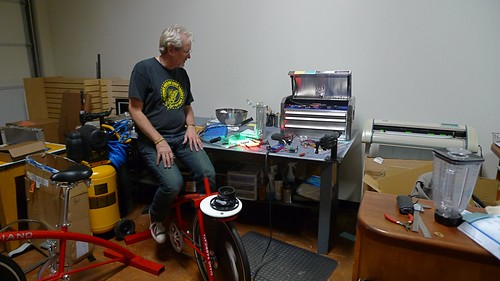
Above: Bob Farr, an old-school Austin Xtracycle rider, and pedicabber, showed up Monday for the Pedal Power Workshop at Pure Austin. The technical delays described above limited our ability to fill the sweaty gym air with solder fumes at the workshop, but I was able to show Bob lots of good data and parts on paper and on Pure’s public iMac. The next day Bob showed up to help me bust out the last few details of installing the generator wheels. Here Bob is pedal powering 80 watts of LED lighting, a successful test of the Electric FB Pro.
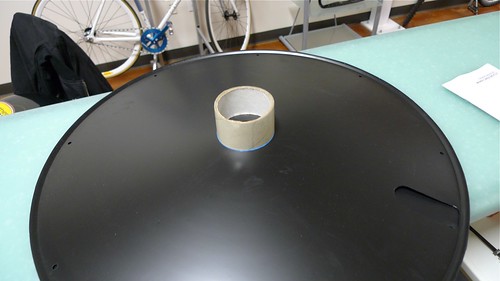
Above: tracing a round object to mark a cut in the wheel covers, making room for the larger hub.
We succeeded in electrifying both of Pure’s Fender Blender Pros. The next step on the project is to build them a Pedal Power Utility Box. I would have liked to have the triumph of a pedal powered spin class, but at least we finished the primary goal of converting the two FB Pros they had, and I won’t have to fly back to Austin to complete the project.
Pure will have time to thoroughly test the system before using it at their fitness expo, March 6.
Read MoreFantastic pedal power social dynamics in the BBC’s powering-a-house experiment
I love how the pedalers get grossed out as they see the father of the house preparing to take a shower. It’s always cool when you can let the pedalers get the best seat in the house at a music event or let them in on a secret. At Rock The Bike’s Pedal Powered Stage events, we serve up smoothies to the pedalers, bike blended of course. We’re thinking of putting the pedalers on a raised stage and lighting them at our Feb. 5th event.
The other moment that’s just classic about this video is when people continue running into the room to add more power and bring the system voltage back to the green. At first, they’re wearing the nice uniform: red jersey and cycling shorts. But as the system voltage continues to get clobbered by the energy hogging electric shower, the producers themselves run into the room wearing street clothes.
And you gotta love the cheering from the crowd when they successfully bring the voltage back from the brink.
A hot shower is, of course, one of the hardest things you can possibly pedal power. Apparently it takes 70 people to do so, (approximately 6000 watts!) Music is just the opposite. 1 person pedaling can get generate about 50-80 PDW (people dancing wildly), reminiscent of how an ant can carry 50 times its own weight in food.
Why is music so efficient? Is it just a coincidence that pedal powering music is easier than pedal powering lighting (even LED lighting), projecting a movie, or cranking out a smoothie, in terms of the number of people who can enjoy one person’s effort?
I think not. Think back to the ancient roots of music: drumming in the Savannah of Africa or the plains of North America that would bring people from a wide distance to gather at the fire. Music and dancing may be a cosmic gift of our evolution, a tool for humans to form communities, and therefore better band together, meet challenges, and fight external threats. This is the theory put forward by Barbara Ehrenreich in her book “Dancing In The Streets: A History of Collective Joy”
Read More


